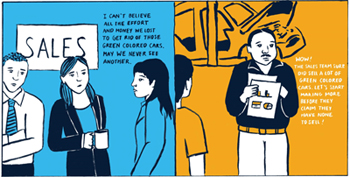Watson Says... |
 |
| There is a lot of opportunity to improve S&OP within organizations. This can range from simply opening lines of communication to using more advanced algorithms to automate and assist with the decision making. |
 |
What do you say? |
 |
| Click here to send us your comments |
|
|
|

At the time, the moral of the story was that your sales and operations team should talk to each other to prevent these kind of problems.
Fast forward to today and there are four lessons we can take from this same story:
First, people still need to hear this story.
Kristen Daihes has spent her career in the Consumer Goods space, working her way to VP of Global Supply Chain at S.C. Johnson & Sons and keeps her pulse on the industry. She claims that functional areas (sales, operations) within companies are still not talking like they should and the green car problem happens more than people will admit.
Second, as you automate decisions, get the features right.
The term “features” refers to the type of data you feed into the algorithms that are making the decisions. For example, if you are trying to automate production decisions, and the only input you have is the of cars sold by their color, you will have automated the green car problem. Instead, you want the features to also include things like profitability, discounts given, and age of the inventory when sold. Then, the algorithm would see that although a lot of green cars were sold, they were sold at a loss after a long time in the lot. This would discourage the algorithm from wanting to make more green cars. Investing time in engineering and creating features is important.
Third, with machine learning algorithms, you can detect the green car problem before it is a big problem.
By monitoring the data carefully and looking for subtle patterns, machine learning algorithms can start to raise early warning signs that something has changed with green cars. This is especially important if you have thousands or hundreds of thousands of different products you need to watch over. In other words, you don’t need to depend on some lucky mention in the monthly S&OP meeting that there seem to be a lot of green cars. You can have algorithms detect this automatically.
Fourth, machine learning can also help point the way out of a problem.
Given that you are stuck with excess inventory, you can also use algorithms to get out of the problem. The algorithms can help determine the discount needed to move the items and the customers most likely to purchase the excess items. This information would have been helpful to the team trying to clear the green cars out of inventory with the minimal amount of damage.
Final Thoughts
There is a lot of opportunity to improve S&OP within organizations. This can range from simply opening lines of communication to using more advanced algorithms to automate and assist with the decision making.
1. As a funny little note. When Hau Lee first told the story, he used the term “green cars.” In 2017, when I used the same story, all the people who edited this article thought Hau Lee was talking about environmentally friendly (in others words, “green”) cars. So, I changed this to green colored to avoid confusion. I thought about changing the color to orange, but it didn’t feel like it was my story to change.
Any reaction to this Expert Insight column? Send below.
Your Comments/Feedback
|
|
AL
CSM, N/A |
Posted on: Apr, 25 2024 |
|
Thanks for this story. It appears the Volvo incident happened on the 90s. Unsure if they resolved it via open communications or this is was more an anecdotal story with some facts sprinkled in as a lesson.
Great article wth real-life examples of how to go about resolving the bullwhip effect. |
|
|